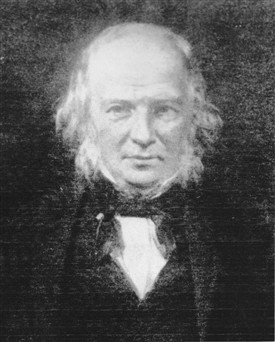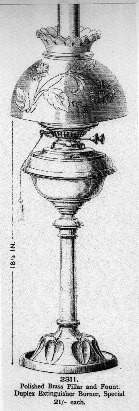Addiewell Oil Works in 1865

James "Paraffin" Young
West Lothian Local History Library. WL 407

Oil lamp made by Young's Paraffin Light and Mineral Oil COmpany at its Clissold Works in Birmingham.
West Lothian Local History Library. WL. 406.
Site of the clay pit. The brickworks were just northeast of the claypit.
The earliest report, printed in the Scotsman of 16 May 1865.
By Sybil Cavanagh
The earliest known description of the Addiewell Oil Works appeared in the Scotsman newspaper of 16 May 1865. Who the writer was is not known, but he gives a thorough report of the site, the shale mines, and the village - which included lots of wooden huts for the labourers engaged on building the works.
The houses were built from Addiewell-made bricks. A clay pit was dug very close to the site - near the station - and the clay was made into bricks in a brickworks beside the clay pit.
'The works are to be divided into two almost equal parts by a broad open way running like a street down the centre. Down this street a branch line of railway will be led, upon which a small steam locomotive will be placed. This line, laid down so as to form direct communication with the coal-pits, will afford the means of conveying the shale to the retorts with little trouble, and can be used generally for the conveyance of goods to and fro within the works.'
James Paraffin Young was an astute businessman. Having worked out how to get oil from minerals, he set about creating a market for his product. He set up a lamp-making factory in Birmingham, which would burn his shale oil. And his vision of the Royal Navy's ships being fuelled by shale oil was to come true long after his death.
'The paraffine oil, [Young] thinks, may also come to be advantageously used for the fuel of steamships. Being liquid, it could be stored in out-of-the-way places, thereby economising space... A ton of paraffine oil would go as far as a ton and a half of coal, and would only occupy 36 cubic feet, as against the 72 cubic feet required for a ton and a half of coal. Nor does this idea of substituting oil for coal as the fuel of ships seem chimerical or impracticable. The Duke of Somerset recently expressed a confident hope that the time was approaching when the ships of the navy would carry petroleum as fuel in place of coal. This result realised, the development of the oil trade in Scotland would receive an impetus that would make it rank among the most important of our manufactures.'
Read the whole article in the PDF at the foot of this page.